The post Spreading Joy At Mardi Gras appeared first on The Expeditioner Travel Site.
]]>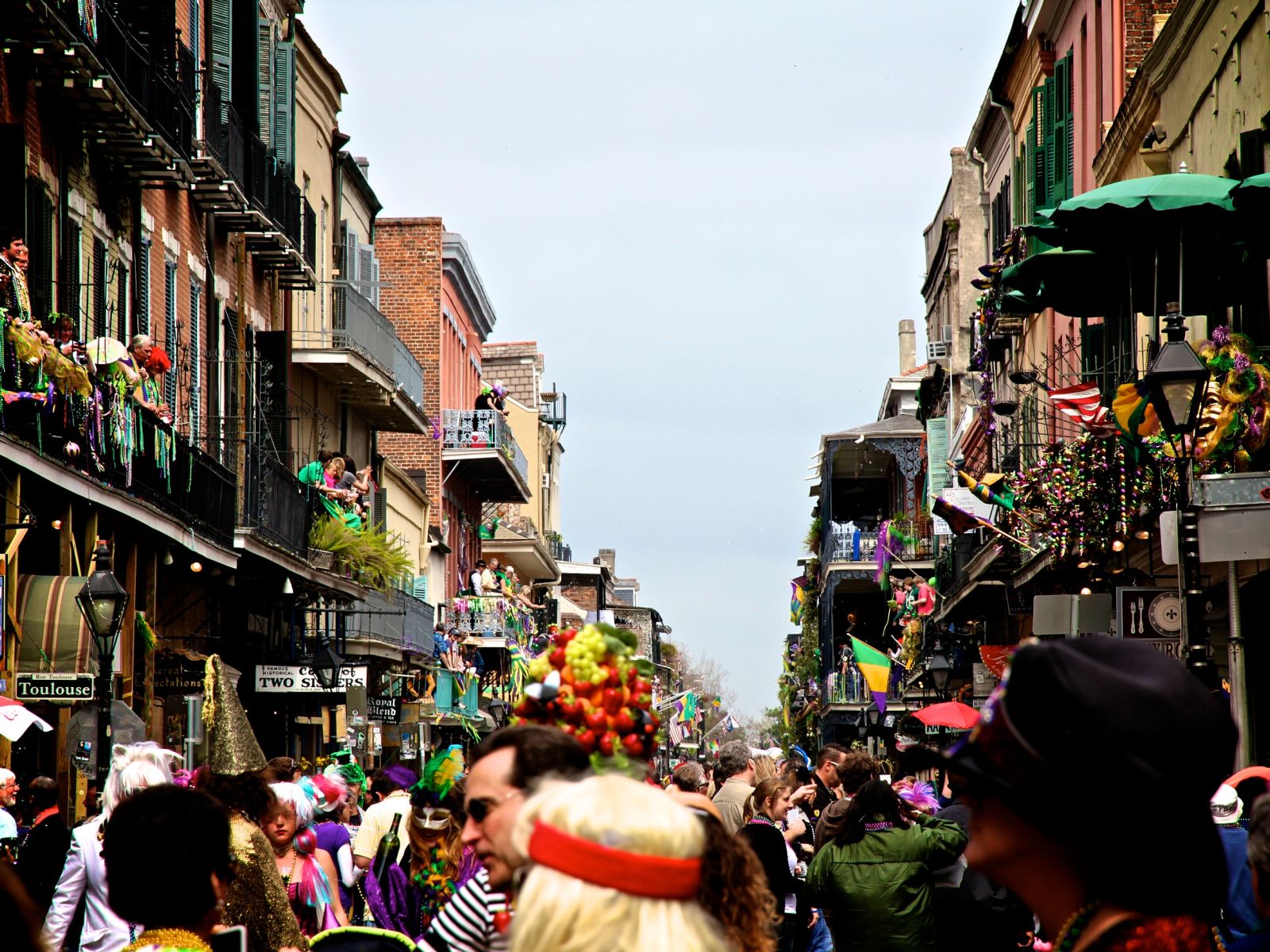
When my friend Kendra asked me to ride krewe with her on a Mardi Gras float I was unsure. We sat at the dining room table of my Seattle apartment one chilly fall night, cradling our wine glasses, polishing off a second bottle of red.
“What about the crowds?” I asked. I hated crowds and had always sworn off Mardi Gras because of them.
“You’re above the crowds on the float,” she assured me.
Kendra, a New Orleans native, rode Krewe of Tucks the year before Hurricane Katrina. Now, 10 years later, she wanted to ride again. Krewes are social clubs that organize Mardi Gras parades, their origins lie in New Orleans secret societies and early city politics. Some are huge: Endymion and Bacchus are festivals unto themselves. Others are niche, like Krewe of Barkus, which is for dogs. Krewe of Tucks, formed by Loyola graduates in the late ’60s, is known for its irreverence, sense of humor and toilet-themed throws. To ride you have to be invited, or ask to be invited, by the krewe.
“How much does it cost?” I asked.
“You pay to ride and then you buy your own beads,” she explained. “You could easily end up spending a thousand bucks or more on beads.” I reached for another bottle of wine. “You don’t want to be cheap with beads,” she advised. “If the crowds don’t like what you throw they’ll throw them back at you. And if you run out before the end it’s embarrassing. It happened to me.” I poured more wine.
“Look,” she said, standing up, grabbing an imaginary string of pearls and throwing them to an invisible parade goer, “think of it as spreading joy.”
I told her I would sleep on it and the next week I mailed in my deposit check. When, I wondered, would I get another chance to throw a thousand of dollars worth of costume jewelry to perfect strangers?
Carnival is a celebration of spring dating back to the Greeks. The Romans turned it into a Bacchanalian orgy. In Renaissance Europe it was a time of aristocratic banquets, masked balls and parades. For Catholics all over the world it is the last blowout before Lent. In New Orleans it is high camp: 12 days of parties and parades culminate into Mardi Gras celebrations where people dress up in costume, wear masks, get drunk and dance in the street.
It is a shared experience of excess that transcends racial and economic boundaries, flipping everyday problems the bird by saying: life can’t be that bad if I am having this much fun. Even the modest Mardi Gras celebration that New Orleans put on six months after Katrina, before hotels had re-opened, before there was even garbage service, boldly showed the world that the Crescent City had survived its near-death experience and was ready to ride again.
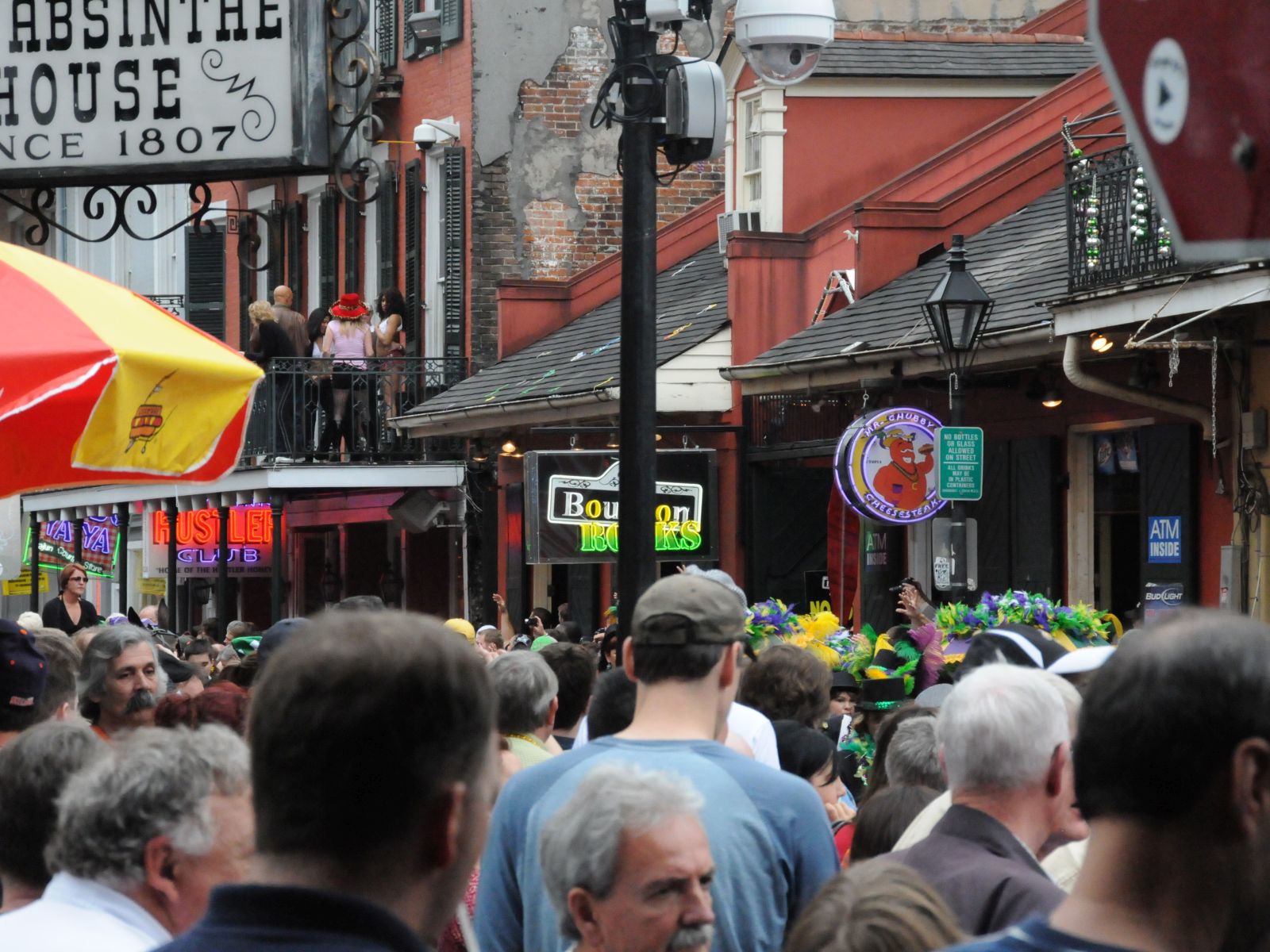
We arrived at the parade starting point on Napoleon Avenue, in New Orleans’s Uptown neighborhood. The mid-morning March sun was already hot, hiding behind a haze of humidity. Brightly colored floats lined the street. A high school marching band practiced hip-shaking New Orleans brass band classics. The Laissez Boys to our right, with their wheeled armchairs, prepared for the parade, bloody marys in hand.
The float was a replica of a casino, and our throwing spot was directly above the “shot wheel” painted on the side. I was already sweating under my purple, gold and green Mardi Gras vest as we began hanging our beads on metal hooks, getting them ready for easy throwing. We had ordered most of our beads online and had them shipped to us. We had bags and bags of them. Some made of large “pearls,” others small, and some made of the tiniest “pearls” of three or more colors braided into a twist.
The day before we had stopped at Mardi Gras Imports to pick up specialty throws for people we really liked: strings of rubber ducks, stuffed snakes and spears. We also had the much sought-after Tucks-branded throws: sunglasses with toilet seats for frames, plungers and toilet brushes. At noon we began to roll. “Rock the Casbah” blasted out of the speakers above us.
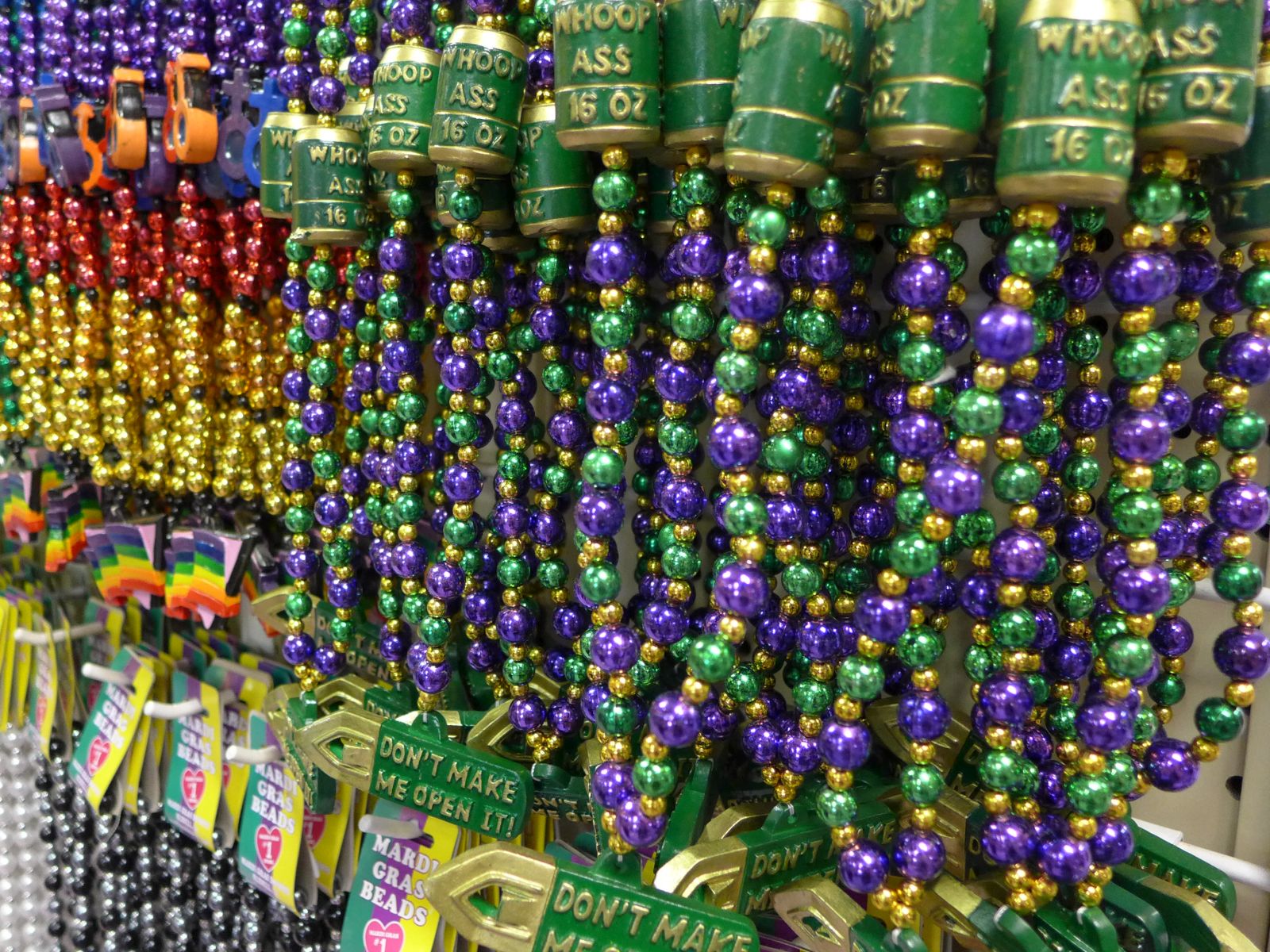
Who should I throw to? Everyone yelled for beads but I wanted to be more discriminate in my throwing so I wouldn’t run out. At first I only threw to children. Their eyes would light up when they caught a toss. One man pointed to his child sitting on his shoulders, so I threw her a string of gold beads. Then she handed the beads to her dad. Obviously parents were pimping out their children to get more for themselves. I stopped throwing to children and started throwing to people who didn’t have many beads. I saw a woman sitting on the ground who seemed to have no beads at all and I threw her a strand of silver globes. She smiled and immediately squirreled them away into the bag of beads at her feet.
Eventually I gave up on a strategy and began throwing to anyone who looked nice, friendly or interesting. Someone I would want to hang out with at home. One woman looked dejected, her friends were having fun than she was. I made eye contact and tossed her a double-twist. Her eyes lit up and she gave me a big smile. An electric instant between two strangers! Like I’d given her the best surprise gift ever.
Fling, fling, fling!
The float turned onto St. Charles Avenue and headed downtown. Purple and gold beads hung in tree branches from previous Mardi Gras parades. We passed grand Garden District balconies filled with bead-adorned revelers holding champagne flutes and screaming, “Throw me some beads!” People knew what they wanted and would ask for it. One reveler locked eyes with me and pointed to the string of rubber duckies he wanted. What could I do but oblige?
We continued moving towards downtown, crossing streets named for the Greek Muses: Terpischore, Thalia, Erato, Clio. The crowds grew bigger after every intersection.
The crowds always wanted more: more doubloons, more double twists. “You got any plungers left?”
When the crowd got too demanding I would sit down, hidden from the crowd by the wall of the float, take a breather and a few gulps wine from my sippy cup.
As we neared downtown I realized I’d been throwing beads too sparingly, I’d been too picky. By Lee Circle, the halfway point, I still had bags and bags of throws left. I began throwing by the fistful.
Fling, fling, fling!
Entering the downtown business district the crowds were thicker and barricades appeared. I could no longer make eye contact; I had lost my human connection, but I had way too many beads left. I threw like my life depended on it, like I was on the sinking Titanic and jettisoning ballast would help me to survive.
We turned onto Canal Street, with its colonnade of Royal Palms. At Chartres Street, the entrance to the French Quarter, the ride was over. I was hot, comfortably drunk and disoriented as I left the float. I still had three large bags of leftover beads.
Not knowing what to do with them I walked down to the sidewalk and set them on the pavement. People would love them, I thought. But nobody noticed. People walked around them. They were just like the other beads, broken from throwing, strewn all over the sidewalk that nobody would pick up. Without the human connection on the other end, without a person spreading joy from the top of the float, they were just beads. Plastic. Joyless. Made in China.

[Mardi Gras 2011 by Brad Coy/Flickr; Mardi Gras by Larry Johnson/Flickr; Mardi Gras Beads by Author]
 A notebook, a camera, and a penchant for exploration have been in Mark’s knapsack from a young age. A business consultant in Seattle, Mark travels as much as he can get away with and writes about it on his blog, WilderShores.net.
A notebook, a camera, and a penchant for exploration have been in Mark’s knapsack from a young age. A business consultant in Seattle, Mark travels as much as he can get away with and writes about it on his blog, WilderShores.net.
The post Spreading Joy At Mardi Gras appeared first on The Expeditioner Travel Site.
]]>The post Five Lessons Learned While Weekend-ing In New Orleans appeared first on The Expeditioner Travel Site.
]]>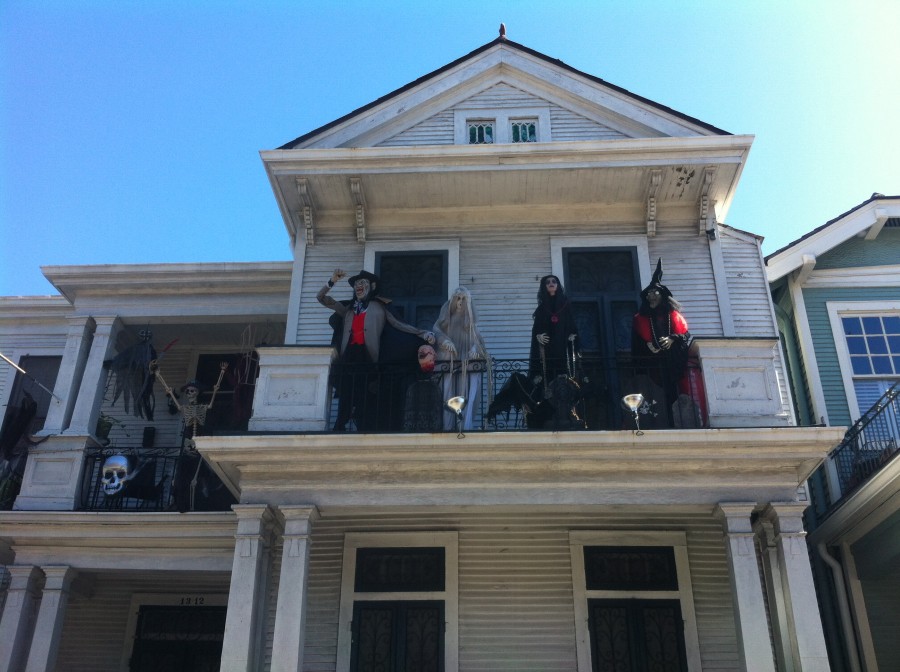
If traveling is about the journey, then there are lessons to be learned. Weekend-ing in New Orleans was one of those practical adventures that had less to do with voodoo and more to do with the real situations of getting, living, and leaving there.
Lesson one: sometimes you have to DIY. Upon arrival at YYZ, Toronto’s International Airport, the early flight was pushed until later. You know what they say, tired heads lead to disappearing boarding tickets. After a mad scramble for a lost boarding pass, we had to pass on the plane. We decided to talk to the United Airlines representative who said she didn’t really know what to do, and that we should call our travel agency. Our travel agency was an affiliate of SkyScanner, the bargain flight search engine. Our “travel agent” re-booked our flight for 5 p.m., and was willing to charge us a mere $1,400. I refused the courteous offer and began thinking of other places that we could go for a weekend: Montreal, New York, Chicago . . . In the end, a woman from another airline said we should call United directly. “Just do it yourself, this woman doesn’t know what she’s talking about.” So, we did and our tickets were re-booked free of charge. We went to the airport bar to celebrate.
Lesson two: if you are flying United Airlines, beware of your stopover times. The airline may not take layovers into account, which means you should. So, there is less than an hour between flights, find another flight with an hour or more in between. That means that even if you are on one of the brand new airplanes — so new that they are too tall to connect with the gate and are delayed thirty minutes — you will still have enough time to make your next flight instead of rooming in an Econolodge in Humble, Texas.
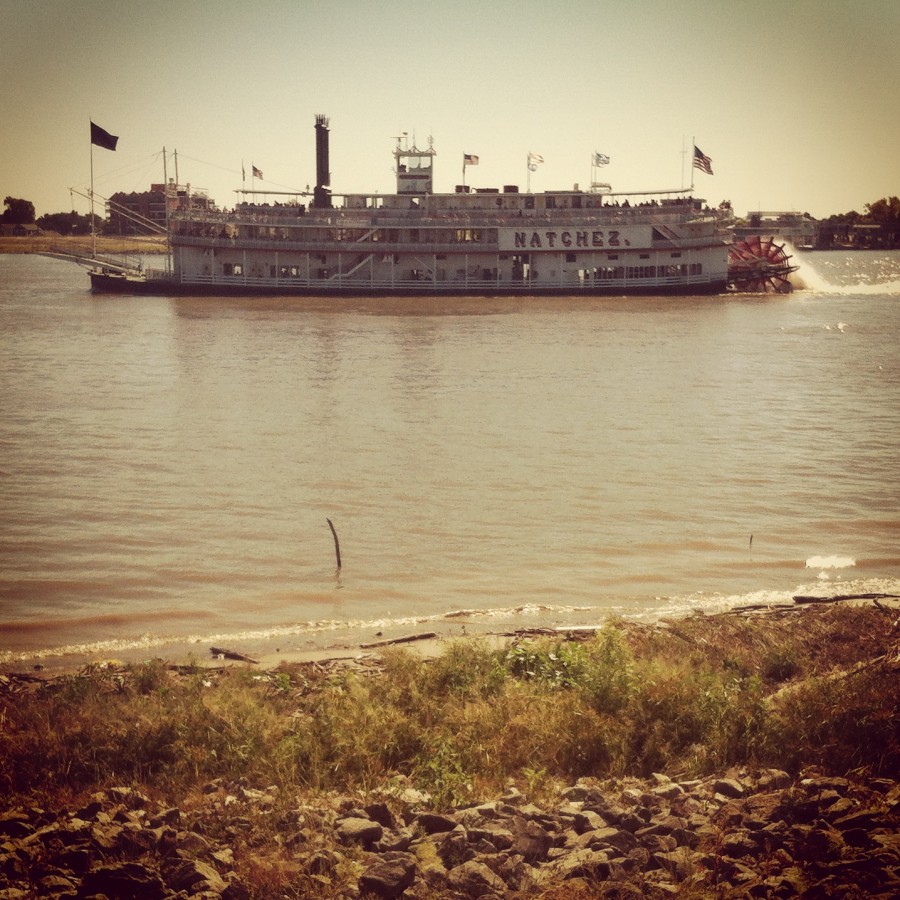
Lesson three: when booking with AirBnB, research the heck out of your neighborhood, including the difference that a block or two would make. When booking the room in NOLA, I understood that the house was close to the French Quarter, but I didn’t understand it was on the other side of the highway in the 7th Ward. The other side was a little rougher and a bit more real than I had expected, which is amazing if that’s what you are expecting. After talking with friends and locals, each suggested that we take cabs back to our rental because, “This is the South, little honey, and the kids got guns. If they want what you have, they will shoot you.”
The advice was greatly appreciated, and after we cabbed back to the house on our last night, we found out the neighbors had been broken into. The kids from Chicago that were staying there had all their valuables stolen and the rest of their stuff just discarded in the backyard.
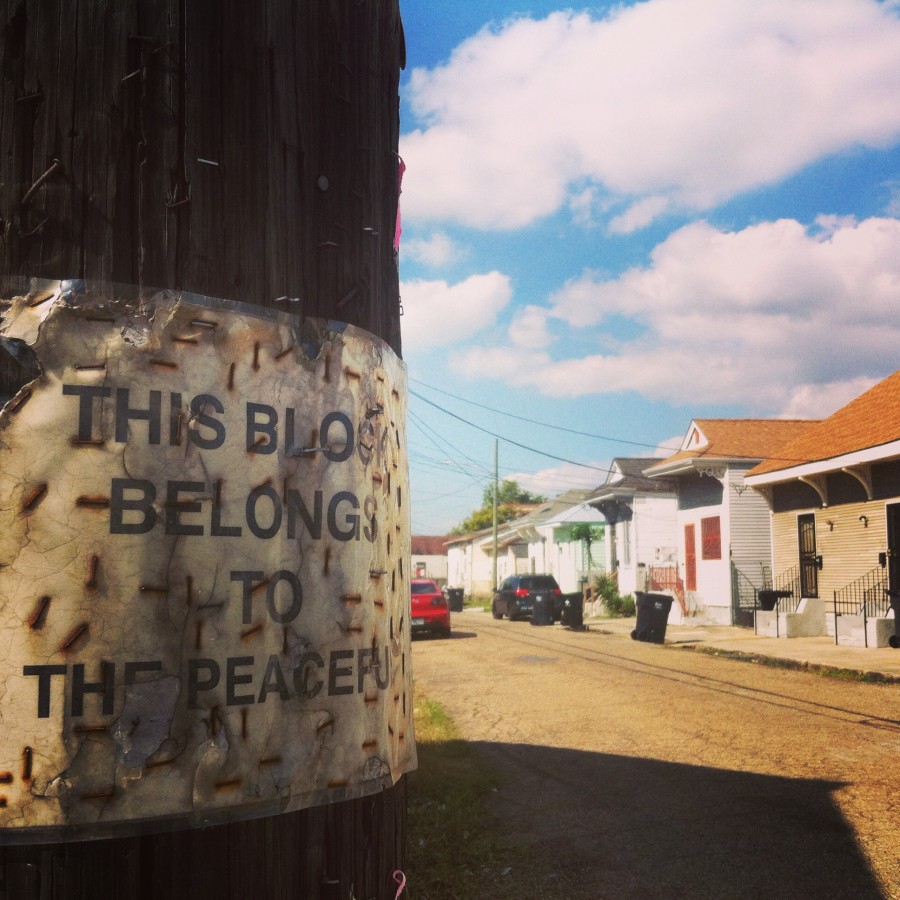
Lesson four: go in expecting the unexpected. It may not be Bourbon Street the whole time, or even at all. Instead, Royal Street had all the glamor and less of the gigantor daiquiris. Chartres, Decatur, and that lovely Canal Street were more than enough excitement and voodoo to last a decade.
Lesson five: laugh. You have to. It is quite humbling to allow life to take you through unexpected movements. Pat yourself on the back that you survived another adventure in all its real glory. Enjoy that you had real conversations with real people who had left post-Katrina and are slowly migrating back to re-establish their lives. Relish that French colonial architecture and the legendary southern hospitality. Don’t forget to dabble in the hot sauce, sip a coffee while dunking your doughnut in Cafe du Monde, and if you don’t go swamp crawling, at least eat a little alligator.

 Toronto born and based, Brit Weaver is an avid leisurely cyclist, coffee drinker and under-a-tree park-ist. She often finds herself meandering foreign cities looking for street eats to nibble, trees to climb, a patch of grass to sit on, or a small bookstore to sift through. You can find her musing life on her personal blog, TheBubblesAreDead.wordpress.com.
Toronto born and based, Brit Weaver is an avid leisurely cyclist, coffee drinker and under-a-tree park-ist. She often finds herself meandering foreign cities looking for street eats to nibble, trees to climb, a patch of grass to sit on, or a small bookstore to sift through. You can find her musing life on her personal blog, TheBubblesAreDead.wordpress.com.
The post Five Lessons Learned While Weekend-ing In New Orleans appeared first on The Expeditioner Travel Site.
]]>The post Trippy Award Winners Announced appeared first on The Expeditioner Travel Site.
]]>Congratulations to Travel Bug Robert for his recent win at the oh-so-prestigious Trippy Awards as Filmmaker of the Year over at Trip Films. Rob uploaded a whopping 32 videos in 2010 alone, documenting trips in such places as L.A., Brussels and Ireland.
In honor of the end of Mardi Gras, we’ve posted Rob’s video from his trek out into the New Orleans nightlife, impromptu jazz band and all.
The post Trippy Award Winners Announced appeared first on The Expeditioner Travel Site.
]]>The post Fat Tuesday 2011: Mardi Gras By The Numbers appeared first on The Expeditioner Travel Site.
]]>
In celebration of Fat Tuesday 2011 and the end of Mardi Gras (Mardi Gras is the last Tuesday before the beginning of the Lent season that kicks off with tomorrow’s Ash Wednesday), I though we’d take a look at Mardi Gras by the numbers as it effects New Orleans.
According to this infographic by Fast Company, Mardi Gras in New Orleans is back with a vengeance. Last year, 1.2 million people attended Mardi Gras — 3.5 times the population of the city and up about a 1/3 from the year before, the city spends $3.33 million to celebrate (of which they gain a return of $4.48 on every dollar spent), and the average hotel-goer can expect Bourbon Street prices to increase 151% from their normal prices during the 12 days leading up to Fat Tuesday. And for those of you playing at home, check out these Hurricane recipes for your own taste of the Big Easy in your living room tonight.
The post Fat Tuesday 2011: Mardi Gras By The Numbers appeared first on The Expeditioner Travel Site.
]]>The post Why Can’t More Cities Be More Like New Orleans? appeared first on The Expeditioner Travel Site.
]]>
After a bumpy ride through water damaged roads and partially boarded up houses, our taxi deposited us in a crowded and lively Jackson Square, the heart of New Orleans’ French Quarter. Jazz, the heartbeat of this area, poured out of storefront speakers, screamed from portable CD players, and blended mercilessly with live combos on every street corner. To use an old phrase: the place was hopping.
The settlers of New Orleans knew what they were doing when they built their original city on high ground. The French Quarter survived the floods of Katrina with little damage to the historic streets and buildings, but did sustain major damage to the tourist industry. A visit to the city today shows that whatever damage to the French Quarter that occurred, that is now all in the past.
On one side of the plaza the famous Cafe Du Monde was three deep with people waiting for a table and a chance to try their famous coffee and beignets. Street artists lined themselves around the small central park, hanging their pictures on the old, wrought-iron fence and propping them against any available tree, easel or wall. Wild caricatures of vibrantly painted jazz musicians vied with delicate water color depictions of the plaza and the venerable old streets, while soulful abstract works added to the eclectic mix.
The sounds of clapping and cheering from the far side of the park drew us to a large group gathered on the waterfront that were enamored by an enthusiastic performance of dancers and acrobats. We eventually wandered away from the noise and found the small park in the center of all this activity to be an unexpected oasis of quiet and charm. Tree-lined paths and secluded benches gave the weary visitor a place to sit and relax.
Since we were only in New Orleans for a day, there was little rest for the weary. We set off — torn-out pages of our guidebook in hand — to discover the old city. We left the largest crowds behind as we spent the afternoon tracing the French Quarter’s history, from the golden statue of St. Joan, to an old monastery, to the blacksmith-shop-turned-bar headquarters of the pirate Jean Lafitte, to, finally, the home-turned-bookstore of William Faulkner.
 The lace-like iron balconies were as beautiful as expected, but it was the musicians on every corner of the cobbled streets that were the most memorable. The heavyset old woman with the sweetly delicate voice still haunts me, as does the unique jazz sound of a violin and guitar duet playing on a nearby corner. We resisted the temptation to join the other onlookers who had spontaneously broke out into dance in the street, and instead looked for somewhere to grab a drink. This was the French Quarter after all.
The lace-like iron balconies were as beautiful as expected, but it was the musicians on every corner of the cobbled streets that were the most memorable. The heavyset old woman with the sweetly delicate voice still haunts me, as does the unique jazz sound of a violin and guitar duet playing on a nearby corner. We resisted the temptation to join the other onlookers who had spontaneously broke out into dance in the street, and instead looked for somewhere to grab a drink. This was the French Quarter after all.
Without realizing we were stepping into a major landmark, we wandered into Pat O’Brien’s on St. Peter Street. The entrance was shadowy, as were the two small bars on either side of the long entry hall, but it opened up to a large, sunny and boisterously noisy patio crowded with people contentedly sipping the tall, pink and hugely famous concoction known as The Hurricane — a drink the bar lays claim to inventing back in the 1940’s. And as I soon discovered, after a long day exploring the city: One large glass + two straws = very happy patrons.
Next door to O’Brien’s is the famous Preservation Hall Jazz Club that was founded in 1961 to “protect and honor New Orleans Jazz.” The old building didn’t open until the evening, but we were able to peer through the iron gate at the entry hall walls covered with memorabilia. Dusty old black and white photos, colorful posters and tattered playbills themselves told a story of the musical history of the city.
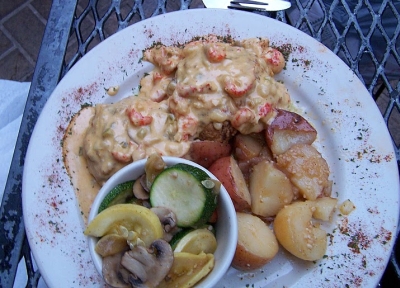 Deciding where to have dinner in a place so well-known for cuisine could have been challenging, but we opted for the Oceana Grill on a quieter side street. Once again, as seemed to be the French Quarter norm — and perhaps a reflection of what the steamy city was like in pre-air-conditioning days — the entry and front rooms were dark and less than inviting, but the patio out back with its waterfall and whimsical art was a delight. For appetizers we snacked on “Jazzy” crab cakes swimming in a crawfish cream sauce, and ordered the Tuna La Boheme for entrees, a perfectly-grilled tuna served smothered with a barbecued shrimp sauce.
Deciding where to have dinner in a place so well-known for cuisine could have been challenging, but we opted for the Oceana Grill on a quieter side street. Once again, as seemed to be the French Quarter norm — and perhaps a reflection of what the steamy city was like in pre-air-conditioning days — the entry and front rooms were dark and less than inviting, but the patio out back with its waterfall and whimsical art was a delight. For appetizers we snacked on “Jazzy” crab cakes swimming in a crawfish cream sauce, and ordered the Tuna La Boheme for entrees, a perfectly-grilled tuna served smothered with a barbecued shrimp sauce.
Contentedly stuffed, we emerged onto a noisy Bourbon Street. The music now truly blared from every door and corner, while street performers — jugglers, pantomimists as well as musicians — worked the crowded streets. The evening revelers, drinks in hand, surged rather than strolled the cobbled streets and the whole feel of The Quarter took on a party atmosphere. This was the New Orleans of legend. Loud, happy and colorful; it was literally throbbing with enthusiasm. If it had faltered for a while, it didn’t show: the French Quarter we saw was inviting, exciting and most definitely back.
By Elaine Stabile

About the Author
Elaine is a freelance writer based out of Worcester, Massachusetts. She is a regular contributor to the Audio Journal, and is an active member of the burgeoning central Massachusetts literary scene.
[Images via the author]
The post Why Can’t More Cities Be More Like New Orleans? appeared first on The Expeditioner Travel Site.
]]>The post Visiting The New Orleans Of “Treme” appeared first on The Expeditioner Travel Site.
]]>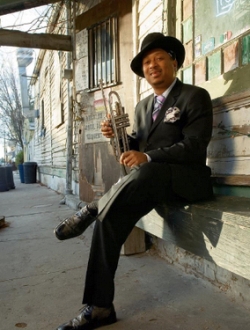
This week GoNomad heads way down south to New Orleans to check out the many locales and characters that crop up in HBO’s new drama, “Treme.” Watching “Treme,” as I’ve been doing the last couple of weeks, I’ve found myself thinking about how there’s very little that’s as an effective tool to sell a city than setting a show or movie there. (Come on, how many twenty-something girls have migrated to New York as a result of “Sex and the City”? Not that there’s anything wrong with that.)
New Orleans, despite the constant bravado and glowing affection the city receives from its locals — especially since the hurricane — has not offered me much to make me want to visit. The fact that some of its most vocal supporters have been none other than Harry Connick Jr. and Angelie Jolie hasn’t helped, and the annoying commercialism and flocks of tourists that is the French Quarter has done little to change my mind.

"Get your hands off me!"
But “Treme” — named after the neighborhood that is considered to be the oldest African-American enclave in the country — dispenses with the niceties and gloss that the travel brochures are chock full of, and instead focuses on the grime that is (or was?) the Lower Ninth Ward, the sound that is the ratty jazz clubs of the Seventh Ward, and the disdain that is ever-present with the locals for the tourists that come in search for the “real” New Orleans among the street musicians of Bourbon Street. Instead the series focuses on the food, the people, and the traditions that have helped shape and create one of our country’s most unique cultures. In other words: all those things that make you fall in love with a city.
As the article points out, ” ‘Treme’ is not meant as a travelogue, but Simon has gone to great lengths to capture the spirit of the city. He revels in its complex traditions, from social and pleasure club parades to Mardi Gras Indians to jazz funerals, all of which are lovingly depicted.” My guess for the rest of the season? We won’t be watching Kermit Ruffins (pictured above) shopping for Manolo Blahniks. And I’m all the more thankful for that.
The post Visiting The New Orleans Of “Treme” appeared first on The Expeditioner Travel Site.
]]>The post Road Trip: New Orleans Style appeared first on The Expeditioner Travel Site.
]]>
Still recovering from that bender known as Katrina, a road trip to the Big Easy reveals how New Orleans isn’t letting a little hangover prevent it from enjoying life, just like it always has.
By Ted Hesson
We decided to take a road trip for several reasons: moving, freelance work, sightseeing, hell-raising, escapism, rock and roll — the usual motives. Since it was freezing cold in New York, the three of us thought it would be smarter to move southerly before hanging a right towards the West Coast. While my two friends ventured on to California, though, my final stop on the trip would actually be New Orleans, a city that I had always wanted to visit. I expected to find, among other things: heaps of spicy seafood, Bayou-tinged blues, unparalleled architecture, non-stop debauchery and the remnants of one of the worst natural disasters in the history of the United States. For better or for worse, it was all there.
From Atlanta, we took the slow road to the Big Easy, making a few stops along the way. We spent an hour in Montgomery, where we discovered a Disney-esque downtown devoid of inhabitants, save some chatty pharmacy workers, with whom we talked about New York, Alabama’s quiet capital and, eventually, New Orleans. “Y’all goin’ to New Orleans?” one worker said. “Na, I wouldn’t go if I were you. Y’all gonna get boogled.” Our Yankee ears must have translated it poorly, because I’m sure what she meant to say was that we would get “voodooed,” but either way, I got the point. She thought New Orleans seemed pretty freaky, and as a childhood fan of Anne Rice, I didn’t disagree. But, to put things in perspective, it was rush hour in Montgomery, and I hadn’t heard a honking horn or shouting pedestrian yet. Seemed to be just as good of a chance of getting boogled here as anywhere else. We hopped back in the van and decided to take our chances with whatever witchcraft might lay in wait.
As we drove along Route 90, the strip malls and stoplights became a bit repetitive, but we never lost the ominous feeling inspired by the uprooted oak trees that flanked the road, part of the scars and scabs on the debris-speckled Gulf Coast. This stretch of highway was hammered by Hurricane Katrina but apparently had been restored in November 2007. If there was anything else worth seeing as we drove through the rest of Mississippi, I probably missed it. Relegated to the back of the van, I crashed out on a couple of beanbags until we hit Louisiana.
When I woke up, the landscape had changed dramatically. Sand, surf and palm trees had morphed into swampy bogs. The bayou. Wide-eyed, we rolled along 90, taking in the gray-green landscape, which was occasionally accentuated by an abandoned wreck or roadside fire. It wasn’t long before we came across a hunting party, with dozens of cars parked along the sides of the road. My first, more romantic impulse was to guess that they were shooting gators, or perhaps hunting a swamp rat of mythical proportions, but they were probably after ducks or quail. When we stopped to take some photographs a little farther down the road, we heard gunshots.
* * *
By the time we reached New Orleans around 5 p.m., we were ready to stretch our legs. Well, that or hunker down on the nearest barstool. Turns out those stools were at Fat Harry’s, a smoky pub with sticky tables and friendly faces, where we planned to meet our friend Sara whose house we’d be crashing at that week. Uptown — the neighborhood southwest of the French Quarter — where Sara lived was one of the places that didn’t flood during Katrina because of its higher elevation, and although some of the buildings in the historic area suffered wind damage, we didn’t see any visible reminders of the storm.
We met Sara at the bar and ordered a few bottles of something called Purple Haze. If the uprooted trees on our ride towards the city felt foreboding, a beer named after a Hendrix song seemed quite the opposite. As it turns out, the Haze, a light, raspberry-flavored wheat beer, is made by the local brewing company Abita, so we were getting a taste of the native drink as well. After we chatted with Sara for a bit (Her thoughts: “Wow, these guys look balder and fatter than I remember them”), she suggested we walk to Casamentos Oyster House for dinner. We wanted to finish our beers first, but soon realized that chugging would be unnecessary: we watched as the locals poured their drinks out of their pint glasses and into plastic cups.
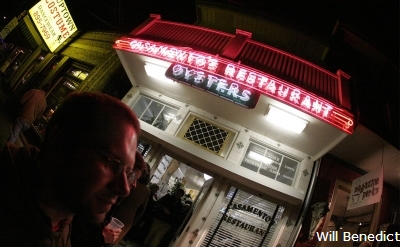 Beers in hand, we headed toward Casamentos (4330 Magazine St., 504-895-9761), about a five- or ten-minute walk down Napoleon Avenue to a part of Uptown that was closer to the Touro neighborhood. On the way, someone pointed out St. Elizabeth’s, a former orphanage that was purchased by Anne Rice in 1993 and transformed into the kind of vampire-esqe lair that you might expect to find in one of her books. The entrance to the enormous red brick building — heralded by Corinthian columns and guarded by stone seraphim — hinted at the incorporeal, despite the fact that the property had been sold a few years back and converted into condominiums.
Beers in hand, we headed toward Casamentos (4330 Magazine St., 504-895-9761), about a five- or ten-minute walk down Napoleon Avenue to a part of Uptown that was closer to the Touro neighborhood. On the way, someone pointed out St. Elizabeth’s, a former orphanage that was purchased by Anne Rice in 1993 and transformed into the kind of vampire-esqe lair that you might expect to find in one of her books. The entrance to the enormous red brick building — heralded by Corinthian columns and guarded by stone seraphim — hinted at the incorporeal, despite the fact that the property had been sold a few years back and converted into condominiums.
When we got to Casamentos — one of the best oyster houses in the city — we ran headfirst into a 45-minute wait. After some discussion — and fresh beers from the bar next door — we decided to head elsewhere. I was a bit disappointed. With its tiny tables and tiled walls, Casamentos seemed to have a lot of character. “The tiled walls make it easier to clean up after mob hits,” I overheard someone say as we were leaving.
Outside, a friend of Sara’s pulled up in an SUV, and we all crowded inside and headed to Frankie & Johnny’s (321 Arabella St., 504-899-9146), a traditional Nawlins Cajun joint in the southwest section of Uptown. From the neon beer signs in the front windows to the drop ceiling and checkered tablecloths inside, the restaurant felt homier than my grandmother’s living room (although I don’t ever remember her serving beer in pitchers). We sat down at a big table in the back of the restaurant and asked our friends to help us order. More than anything, we wanted to try food from the bayou, so for appetizers we settled on a mess of broiled crawfish, gator nuggets and fried pepper rings.
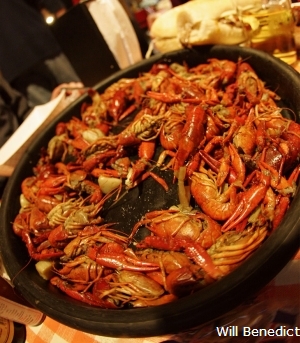 When the crawfish came out we felt a bit helpless. Here we had a heaping pile of blushing crustaceans in front of us and not the remotest idea of what to do next. Luckily, Sara demonstrated for us, pulling the head off on an inaugural critter, squeezing the meat out of its tail, and then slurping the spicy juices out of the detached head — all the while maintaining the posture of an airline stewardess. On my first try, the crawfish juice exploded on my shirt and glasses, but before long I got the hang of it and I was pulling, squeezing and sucking as if I was the star of a seafood-lover’s fetish film. The gator bites, which came with remoulade sauce on the side for dipping, were good, but pretty much tasted like chicken and perhaps weren’t as exotic as we had anticipated.
When the crawfish came out we felt a bit helpless. Here we had a heaping pile of blushing crustaceans in front of us and not the remotest idea of what to do next. Luckily, Sara demonstrated for us, pulling the head off on an inaugural critter, squeezing the meat out of its tail, and then slurping the spicy juices out of the detached head — all the while maintaining the posture of an airline stewardess. On my first try, the crawfish juice exploded on my shirt and glasses, but before long I got the hang of it and I was pulling, squeezing and sucking as if I was the star of a seafood-lover’s fetish film. The gator bites, which came with remoulade sauce on the side for dipping, were good, but pretty much tasted like chicken and perhaps weren’t as exotic as we had anticipated.
For dinner we ordered po’ boys of all different varieties: oyster, catfish, chicken, hamburger. Po’ boys are essentially subs with some sort of fried fish or meat in the middle, but make no mistake: these are po’ boys — not subs, not hoagies and not even “poor boys.” These are po’ boys. Respect. I ordered mine with fried oysters and asked for it “dressed,” meaning that I wanted the sandwich with lettuce, tomato, mayonnaise and pickles. During the course of the meal, I took a bite of just about everyone’s po’ boy, and I have to say, they were all pretty delicious. It’s hard to go wrong with fried fish on full-bodied, flaky, baguette-like bread.
After a nightcap at a local watering hole (it was only 10 p.m., but the beer had been flowing unsparingly all night), we retired to Sara’s place, which was what they call a shotgun house. Yep, you guess it: that essentially means that you should be able to stand at the front door, shoot a firearm through each room of the house, and have the bullet go out the back door without hitting anything. Imagine the real estate deal: “Can I shoot my gun through it? I’ll take it.” Aside from the structural points, the house felt time-tested, as if it could speak to a century’s worth of hurricane parties, crawfish boils and Mardi Gras parades. There were even impish little gargoyles decorating the front door, and I got the feeling that one could get boogled if he or she wasn’t careful.
* * *
The next day we woke up with a few cobwebs in the brain, but soon realized that a late-night rainstorm had given way to a bright and temperate Sunday morning. Sara and her husband had some social obligations to tend to, so the rest of us decided to relocate to a hotel on Bourbon Street and spend the afternoon and night carousing there. Though before parting ways, Sara took us out to breakfast at The Trolley Stop (1923 Saint Charles Ave, 504-523-0090), an affordable greasy spoon in the Lower Garden District where I treated my hangover with a plateful of biscuits and gravy, sausage, and intravenous fountain Coke. As we ate, we watched an occasional streetcar pass by the window. Sara explained that streetcars are never called trolleys in New Orleans, despite the restaurant’s moniker. Afterwards, we all felt a good deal more healthful (strange that sausage can have that effect), and we climbed back into Sara’s car for a quick drive around the city, including what she laconically called the “death and destruction tour” of neighborhoods that had been damaged by the storm.
We worked our way down St. Charles Avenue, fawning over the magnificent rows of houses on either side of the road, and occasionally flabbergasted by a library or school that looked more like an aristocrat’s mansion. From there we passed through the CBD, which sounds like a government agency or a venereal disease, but in actuality stands for “Central Business District.” The CBD is where you’ll find New Orleans’ high-rise office buildings and hotels, not to mention the Superdome. After that we continued on to the French Quarter, passing by dozens of eye-catching but quaint Creole cottages, painted pink, peach and turquoise.
 Eventually, we reached the Upper Ninth Ward. During the ride, we passed some storm-wrecked buildings and a few homes with black X’s spray-painted over their front doors, a relic from the days after Katrina when rescue teams marked the homes that had been evacuated. But it wasn’t until the Upper Ninth Ward that we got our first taste of the devastation that the storm had wrought. The neighborhood had been restored, but most blocks still had houses in disrepair, slumping and battered ghosts that would hang around until the owners could scrape together enough money to repair them. We passed a section of new houses called the Musicians’ Village, where Habitat for Humanity built over 70 homes in the Upper Ninth Ward for working musicians and their families. Although there weren’t many people around, the on-going construction let us know that the rebuilding process was making headway.
Eventually, we reached the Upper Ninth Ward. During the ride, we passed some storm-wrecked buildings and a few homes with black X’s spray-painted over their front doors, a relic from the days after Katrina when rescue teams marked the homes that had been evacuated. But it wasn’t until the Upper Ninth Ward that we got our first taste of the devastation that the storm had wrought. The neighborhood had been restored, but most blocks still had houses in disrepair, slumping and battered ghosts that would hang around until the owners could scrape together enough money to repair them. We passed a section of new houses called the Musicians’ Village, where Habitat for Humanity built over 70 homes in the Upper Ninth Ward for working musicians and their families. Although there weren’t many people around, the on-going construction let us know that the rebuilding process was making headway.
As we approached the bridge to the Lower Ninth Ward (the two areas are separated by the levied canal), I felt a bit stunned and shell-shocked. It was hard for me to imagine that so many people had lost their homes, and that even after more than three years time, this neighborhood (along with many others) still bore the imprint of the disaster.
Compared to the Upper Ninth Ward — which was battered but in the midst of restoration — the Lower Ninth Ward felt more like a vast vacant lot. We saw the homes that had been built by Brad Pitt’s Make It Right Foundation, which set out to construct homes in the area that would be weather resistant, ecologically conscious and architecturally bold. The homes stuck us as pretty ugly, but the fortress-like designs gave the impression that the buildings could withstand the Gulf Coast’s yearly onslaught of storms, if not another Katrina. Raised on concrete legs, each house had its own strange geometric shape, reminiscent of a Martian settlement dreamed up in the 70’s, while the colors — asparagus, sun-bleached banana and cerulean blue — evoked the shades of the small cottages that were washed away by Katrina. They might be an eyesore, but there was something fresh about the houses, and they hinted at a hopefulness that was harder to see as we passed by the empty concrete foundations and piles of scattered debris that made up the majority of the neighborhood.
After the tour, we said our goodbyes to Sara and found a hotel room on Bourbon Street. While my friends went off to take photographs around the French Quarter, I holed up in Bourbon Rocks, a serviceable, open-air sports bar where I planned to watch a playoff football game. Some might think that was a waste of a beautiful afternoon, but I couldn’t imagine a better way to experience Bourbon Street then at a dingy bar with three-for-one drink specials (three bottles of light beer for $4.50). Needless to say, I was feeling boisterous by the time I met up with my companions at the end of the game, and I was glad that they had brought me a beignet — a deep-fried local pastry that comes blanketed in powdered sugar — to offset the last round of Miller Lite.
We wandered up and down Bourbon Street for the rest of the night, marveling at the hordes of spots to hear live funk, blues and rock bands, as well as the prevalence of dance clubs. Well, not dance clubs exactly, but clubs where the dancers are paid to dance. Around 10 p.m., we refueled at the Oceana Grill (739 Rue Conti, 504-525-6002), a kitchy, somewhat pricey dive just off Bourbon Street, where we made short work of a fiery plate of jambalaya and a bowl of shrimp gumbo. Afterwards, we wandered back down Bourbon Street, entranced by the rambunctious energy of the music, booze and overall good times.
And that was New Orleans: spectacularly spooky architecture, addictive food, the ever-present memory of a calamitous hurricane — all those things that defined the city. Yet on Bourbon Street, a carotid artery of soppy locals, wide-eyed tourists and pushers of every sort, you felt the pulse of New Orleans, a city that will always be ready to embrace the next day, headache or no headache.
The three of us, on the other hand, had been through all we could handle, and Yankee that I was, I boarded my flight back to New York the next day with a feeling of fulfillment and relief. A few hours later I landed safely at JFK Airport, a little tired, but to the best of my knowledge, free of any voodoo curses.
By Ted Hesson

About the Author
Ted Hesson is the online editor of Long Island Wins, a website devoted to immigration news, policy, and culture in Nassau and Suffolk counties.
The post Road Trip: New Orleans Style appeared first on The Expeditioner Travel Site.
]]>